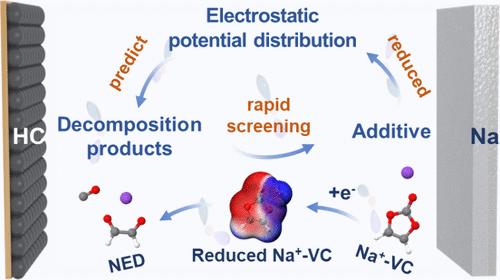失之毫厘:基于静电电位对钠离子电池添加剂有效性的预测
IF 18.2
1区 材料科学
Q1 CHEMISTRY, PHYSICAL
引用次数: 0
摘要
电解质添加剂对于钠离子电池(sib)至关重要,但基于锂离子电池(LIB)原理的电解质添加剂设计存在局限性。值得注意的是,尽管LIBs中的某些标志添加剂已被证明有效,但由于机制不明确,它们在SIBs中不起作用。本研究揭示了还原态结构和静电势(ESP)分布在预测添加剂行为中的关键作用。以碳酸乙烯酯为模型,我们证明即使是微小的ESP变化也会导致不同的还原途径,在sib中形成有害的乙二醇样钠产物(NED),而在lib中形成有益的聚碳酸酯(LVDC)。此外,我们建立了ESP相似性可以有效地预测添加剂的性能,解释了为什么氟化碳酸乙烯和反式二氟碳酸乙烯在sib中表现出不同的行为。除了能够快速筛选用于SIB应用的LIB添加剂外,我们的研究结果强调了电解质微观结构的细微差异如何深刻影响相间化学,强调了对电解质设计进行更深入研究的必要性。本文章由计算机程序翻译,如有差异,请以英文原文为准。

A Miss Is as Good as a Mile: Prediction of Additive Effectiveness in Sodium-Ion Batteries Based on Electrostatic Potential
Electrolyte additives are essential for sodium-ion batteries (SIBs), yet their design based on lithium-ion battery (LIB) principles has limitations. Notably, certain hallmark additives in LIBs, despite their proven effectiveness, fail in SIBs due to unclear mechanisms. This study reveals the critical role of reduced-state structures and electrostatic potential (ESP) distributions in predicting additive behavior. Using vinylene carbonate as a model, we demonstrate that even minor ESP variations can lead to divergent reduction pathways, forming detrimental sodium ethene glycol-like product (NED) in SIBs versus beneficial polycarbonate (LVDC) in LIBs. Furthermore, we establish that ESP similarities can effectively predict additive performance, explaining why fluorinated ethylene carbonate and trans-difluoroethylene carbonate exhibit distinct behaviors in SIBs. Beyond enabling rapid screening of LIB additives for SIB applications, our findings highlight how subtle differences in electrolyte microstructure can profoundly impact interphasial chemistry, underscoring the need for deeper investigations into electrolyte design.
求助全文
通过发布文献求助,成功后即可免费获取论文全文。
去求助
来源期刊

ACS Energy Letters
Energy-Renewable Energy, Sustainability and the Environment
CiteScore
31.20
自引率
5.00%
发文量
469
审稿时长
1 months
期刊介绍:
ACS Energy Letters is a monthly journal that publishes papers reporting new scientific advances in energy research. The journal focuses on topics that are of interest to scientists working in the fundamental and applied sciences. Rapid publication is a central criterion for acceptance, and the journal is known for its quick publication times, with an average of 4-6 weeks from submission to web publication in As Soon As Publishable format.
ACS Energy Letters is ranked as the number one journal in the Web of Science Electrochemistry category. It also ranks within the top 10 journals for Physical Chemistry, Energy & Fuels, and Nanoscience & Nanotechnology.
The journal offers several types of articles, including Letters, Energy Express, Perspectives, Reviews, Editorials, Viewpoints and Energy Focus. Additionally, authors have the option to submit videos that summarize or support the information presented in a Perspective or Review article, which can be highlighted on the journal's website. ACS Energy Letters is abstracted and indexed in Chemical Abstracts Service/SciFinder, EBSCO-summon, PubMed, Web of Science, Scopus and Portico.
 求助内容:
求助内容: 应助结果提醒方式:
应助结果提醒方式:


